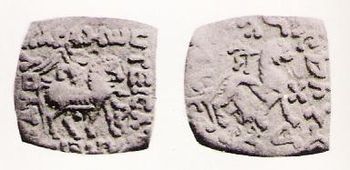
Kharahostes
Encyclopedia

Satrap
Satrap was the name given to the governors of the provinces of the ancient Median and Achaemenid Empires and in several of their successors, such as the Sassanid Empire and the Hellenistic empires....
) in the northern Indian subcontinent around 10 BCE – 10 CE. He is known from his coins, often in the name of Azes II
Azes II
Azes II , may have been the last Indo-Scythian king in northern Indian subcontinent . After the death of Azes II, the rule of the Indo-Scythians in northwestern India and Pakistan finally crumbled with the conquest of the Kushans, one of the five tribes of the Yuezhi who had lived in Bactria for...
, and from an inscription on the Mathura lion capital
Mathura lion capital
The Mathura lion capital is an Indo-Scythian sandstone capital from Mathura in Central India, dated to the 1st century CE.The capital is covered with Prakrit inscriptions in the kharoshthi script of northwestern India...
.
According to F. W. Thomas
F. W. Thomas
Frederick William Thomas was an Indologist and Tibetologist. He studied Sanskrit under the influential Orientalist Edward Byles Cowell at Cambridge. He was a librarian at the India Office Library between 1898 and 1927. Subsequently he was appointed the Boden professor of Sanskrit at Oxford...
, Kharahostes, the heir apparent, was son of Nada Diaka. However, according to Sten Konow, the chief queen of Mahaksahtrapa Rajuvula was Aiyasi Kamuia.
Kharohostes' coinage bear a dynastic mark (a circle within three pellets), which is rather similar, although not identical, with the dynastic mark of the Kushan ruler Kujula Kadphises
Kujula Kadphises
Kujula Kadphises, reigned was a Kushan prince who united the Yuezhi confederation during the 1st century CE, and became the first Kushan emperor...
(three pellets joined together), which has led to suggestions that they may have been contemporary rulers.
Kharaosta of the Mathura lion capital inscriptions is usually identified with the Satrap Kharaostas or Kharahostes. Kharaosta’s known coins are of two types, presenting legends in Greek
Greek alphabet
The Greek alphabet is the script that has been used to write the Greek language since at least 730 BC . The alphabet in its classical and modern form consists of 24 letters ordered in sequence from alpha to omega...
characters on the obverse and in Kharoshthi in the reverse.
The Greek and Kharoshthi legend in the coins runs thus:
Kharahostei satrapei Artauou' : 'Kṣatrapasa Pra Kharaoṣtasa Artasa Putrasa (Of Satra[ Kharaosta, son of Arta) Some of his coins write "Ortas" in place of "Artas".
A recently discovered inscribed silver Buddhist reliquary, found in Shinkot in Bajaur (Pakistan
Pakistan
Pakistan , officially the Islamic Republic of Pakistan is a sovereign state in South Asia. It has a coastline along the Arabian Sea and the Gulf of Oman in the south and is bordered by Afghanistan and Iran in the west, India in the east and China in the far northeast. In the north, Tajikistan...
) refers to a king "Kharayosta", believed to belong to the final quarter of the first century BCE. This king Kharayosta has been identified with the "Yuvaraja Kharosta" in the lion capital inscriptions and the Kharaostasa or Kharahostes of the coins.

